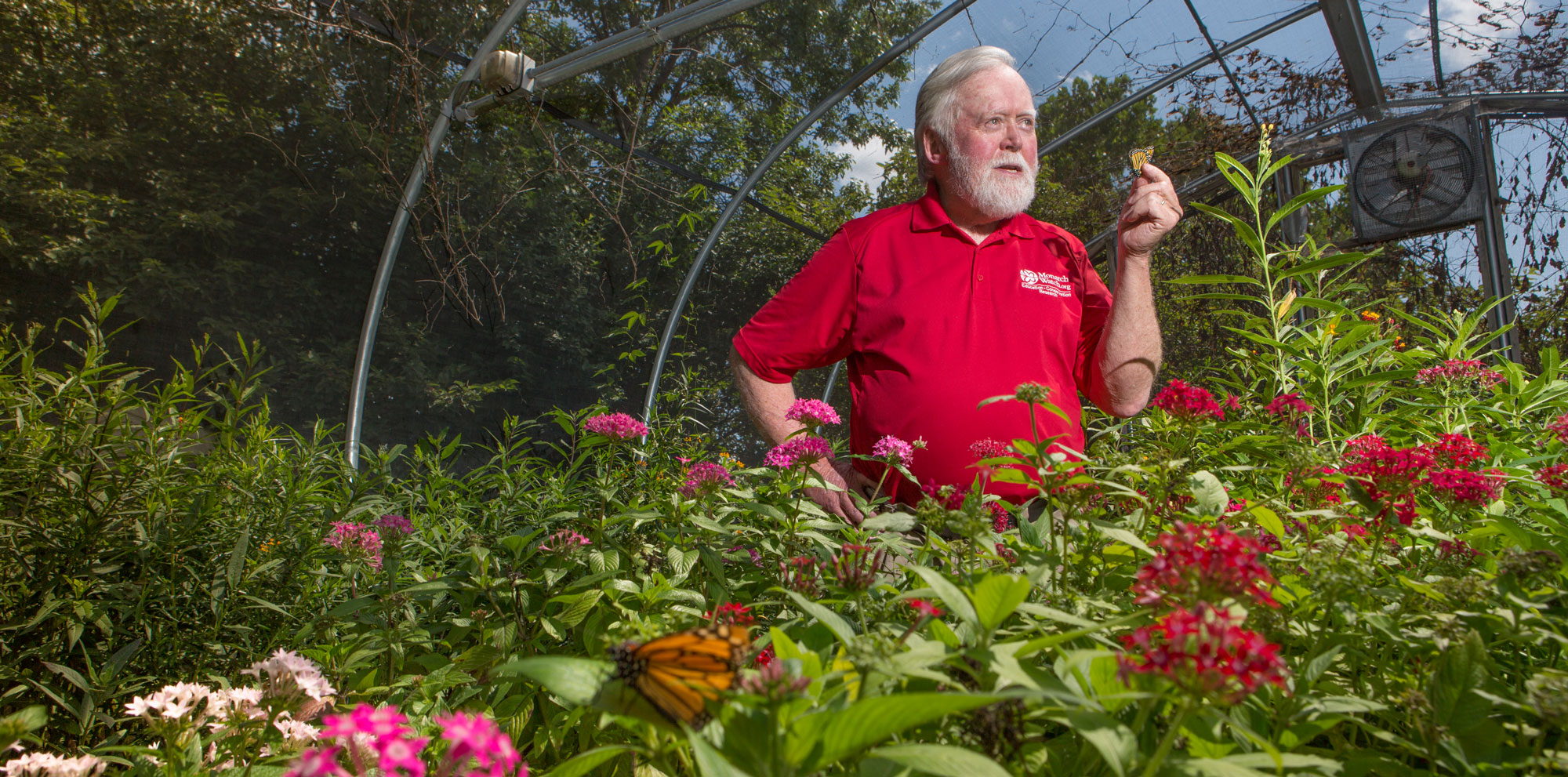Saving the Monarch
Chip Taylor ’66 MS, ’70 Ph.D. wants everyone to plant a little milkweed and bring back the quickly disappearing monarch butterfly.

There is nothing comparable to the sound of tens of thousands of monarch butterflies taking flight — or “cascading” — from an Oyamel fir after being disturbed by a bird or a gentle breeze.
“It’s a rustling, a whispering of wings,” says Orley “Chip” Taylor ’66 MS, ’70 Ph.D. “If you had wings made of paper and you imagine them flapping against each other, it would sound a little bit like that,” says Taylor, an emeritus professor of ecology and evolutionary biology at the University of Kansas and founder of Monarch Watch. “As for the visual cascade, you just sit there and your mouth is open. It’s an awesome thing to view.”
Taylor has seen the spectacle several times in Cerro Pelon, Mexico, a wintering ground at a 10,000-foot elevation that is the southern terminus for millions of the tireless butterflies. From Canada, monarchs fly 3,400 miles, at the rate of 50 to 100 miles per day, for 10 weeks straight. No other insect travels as far.
And perhaps no human is doing more than Taylor to save the black, orange, and white Danaus plexippus, whose numbers have plummeted 90 percent in the last two decades due to herbicide use and habitat encroachment.
Save the milkweed, save the monarch
Monarch larvae feed entirely on milkweed, and particularly in the Midwest, the plant has largely been eradicated by sprayed weed killer. Monarch Watch encourages building “way stations,” aka patches of milkweed.
To date Taylor has encouraged supporters to plant 18,500 way stations around the country — at schools, in home gardens, and in commercial landscaping, but also along highways and at publicly prominent sites, including the U.S. Botanic Garden in Washington, D.C., and the Indiana Dunes National Lakeshore. Some of the patches are as small as 100 square feet. He’s even gained support from the National Resource Defense Council, which has distributed free milkweed plants to schools.
But there’s still plenty of work to be done, says Taylor. Development around the country is eating up an estimated 6,000 acres a day (or 2.2 million acres per year). “We need a million, or maybe several million, way stations around the country to really have an impact.”
The pesticide factor
Monarch numbers have been dropping since 2004, which is when Taylor, who developed an interest in bugs as a kid growing up in St. Paul, Minn., received an email from a conservation-minded farmer in Nebraska.
The farmer had planted “Roundup Ready” soybean seeds, which are designed to withstand sprayings of the Monsanto company’s weed killer. Milkweed cannot survive being sprayed. Taylor says the development was “alarming.”
Habitats have since vanished en masse. The USDA reports that herbicide-tolerant soybeans accounted for 94 percent of all soybean crops in the U.S. in 2014; the total is 89 percent for corn.
In 2010 Taylor began a Bring Back the Monarchs program, which, different from way stations, is an attempt at large-scale habitat restoration. We need “a comprehensive plan to manage the fragmented edges and marginal areas created by development and agriculture, since it is these edges that support monarchs. We need a new conservation ethic,” he says.
Taylor is on the road speaking about such a plan for two weeks of each month. He meets with community groups around the country, urging them to plant nectar plants in addition to milkweed, since hatched monarchs have an all-liquid diet.
It takes a planet
“I have witnessed Chip turn hostile community groups into conservation champions through his patient and prudent approach,” says Laurie Adams, executive director emeritus of the San Francisco–based Pollinator Partnership, a nonprofit that is the largest organization in the world dedicated to the protection and promotion of pollinators and their ecosytems.
“His message is always solid, and his results are unparalleled. There is no one on the planet more committed to the welfare of the monarch butterfly than Chip Taylor,” says Adams.
After earning his doctorate at UConn, Taylor worked as a biologist studying sulfur butterflies. There was one problem: He was allergic to the species, which forced him to reinvent himself. Starting in 1973, Taylor spent 22 years working with Africanized honeybees, so-called killer bees, in South America. When that work came to an end in the early 1990s, he decided to give butterflies another try.
Taylor says Americans have every reason to care about the monarch.
“Monarchs are telling us that we are not doing a very good job of maintaining the biodiversity out there,” he says, noting that the bug, as a pollinator, helps maintain plant diversity. “Biodiversity supports the system that supports us all.
“The fact that this insect is using the same continent we do and is dependent on us to maintain its habitat, that has to resonate with people.”
—Andrew Faught
Photos courtesy of The University of Kansas/Marketing Communications

Leave a Reply